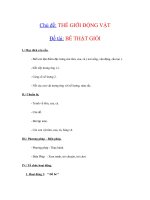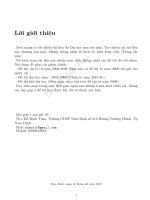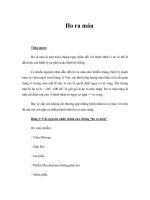jazz piano pdf free download tài liệu piano jazz với các mẫu đệm the jazz ballad simple melody the jazz waltz
Bạn đang xem bản rút gọn của tài liệu. Xem và tải ngay bản đầy đủ của tài liệu tại đây (156.07 KB, 10 trang )
<span class='text_page_counter'>(1)</span><div class='page_container' data-page=1>
&
?
2 3
<b>7</b>
<b>5</b>
<b>3</b>
<b>1</b>
<b>Quality found on I - IV in Major, III -VI In Natural minor and VI in Harmonic minor.</b>
1
<i>Root Position </i> <i><sub>First Inversion Second Inversion Third Inversion</sub></i>
<b>Major Seventh</b>
<b>The Four Diatonic Chord Qualities of Major</b>
C C /E C /G C /B
<i><b>I in C</b></i>
˙˙˙˙
±
œœœœ
±
œœœœ
±
œœœœ
±
˙˙˙˙
b
œœœœ
±
±
œœœœ
±
œœœœ
±
&
?
<b>7</b>
<b>5</b>
<b>3</b>
<b>1</b>
<b>Quality found on II-III-VI in Major, II in Melodic minor, I-IV-V in Natural minor and IV in Harmonic minor.</b>
2 3
1
<b>Minor Seventh</b>
D D /F D /A D /C
<i><b>II in C</b></i>
˙˙˙˙
∆
b
œœœœ
∆
∆
∆
œœœœ
∆
∆
œœœœ
∆
∆
˙˙˙˙
∆
œœœœ
œœœœ
œœœœ
&
?
<b>7</b> <b>7</b> <b>7</b> <b>7</b>
<b>7</b>
<b>5</b>
<b>3</b>
<b>1</b>
<b>Quality found on V in Major, IV-V in Melodic minor, VII in Natural minor and V in Harmonic minor.</b>
1 2 3
<b>Dominant Seventh</b>
G7 G7/B G7/D G7/F
<b>7</b>
<i><b>V in C</b></i>
<i><b>VII in C</b></i>
˙˙˙˙
b
œœœœ
œœœœ
œœœœ
˙˙˙˙
œœœœ
œœœœ
œœœœ
&
?
<b>7</b>
<b>5</b>
<b>3</b>
<b>1</b>
<b>Quality found on VII in Major, VI-VII in Melodic minor, II in Natural minor and II in Harmonic minor.</b>
1 2 3
<b>Half-Diminished </b>
<b> Seventh</b>
B B /D B /F B /A
˙˙˙˙
bb
<sub>b</sub>
ø
ø
œœœœ
ø
ø
œœœœ
ø
ø
œœœœ
ø
ø
˙˙˙˙
ø
œœœœ
œœœœ
œœœœ
<b>Jazz Piano I</b>
<i><b>Ron Di Salvio</b></i></div>
<span class='text_page_counter'>(2)</span><div class='page_container' data-page=2>
&
?
<i>Play the four qualities found in major harmony on each of the twelve notes </i>
<i>on the keyboard. This will produce 48 chords of the seventh,</i>
<b>7</b>
<b>7</b>
<b>5</b>
<b>3</b>
<b>1</b>
<b>7</b>
<b>5</b>
<b>3</b>
<b>1</b>
<b>7</b>
<b>5</b>
<b>3</b>
<b>1</b>
<b>7</b>
<b>5</b>
<b>3</b>
<b>1</b>
<b>Block Chords (Simultaneous)</b>
<b>C </b> <b>C </b>7 <b>C </b> <b>C </b>
<i>Chord</i>
<i>Quality</i>
<i>Chord </i>
<i>Symbol</i>
<i>Chord</i>
<i>Figuration</i>
˙˙˙˙
±
˙˙˙˙b
b
˙˙˙˙b
∆
<sub>bb</sub>
<sub>˙˙˙˙b</sub>
ø
˙˙˙˙
±
˙˙˙˙b
b
∆
˙˙˙˙bb
b
b
˙˙˙˙bbb
bb
b
ø
&
?
<i>Play this broken chord of the seventh pattern using each of the four chord qualities </i>
<i>begining on all twelve notes. Practice all exercises chromatically and in a circle of 5ths.</i>
<i>3rd or 2nd finger Left Hand over RH</i>
<b>Broken Chords (Sequential)</b>
<b>C </b>
œ
±
œ œ œ
œ œ œ
œ
rœ œ œ
œ œ
œ œ œ w
&
?
<i>Play this chord of the seventh pattern using each of the four chord qualities </i>
<i>begining on all twelve notes. </i>
<i>Reverse the pattern- Right hand plays block chords (simultaneous) with inversions </i>
<i>left hand plays broken chords with inversions (sequential). </i>
<b>Broken & Block Chords</b>
œ œ œ
œ œ œ œ œ œ œ œ œ œ œ œ
œ wwww
œœœœ
œœœœ
œœœœ
œœœœ
wwww
</div>
<span class='text_page_counter'>(3)</span><div class='page_container' data-page=3>
&
?
<i>Play the scale and the chords of the seventh in all twelve keys.</i>
<i>Write the letter name and chord quality above each chord in the left hand.</i>
<i>Write out this exercise on manuscript paper in all twelve keys.</i>
<i>Notice the letter names of the chords will change in different keys </i>
<i>while the function and quality will remain constant for all twelve keys. </i>
C D
<b>I II III IV V VI VII I</b>
<b>7</b>
Position
(Function)
Quality
<i>etc.</i>
<b>Scale with Chords of the Seventh</b>
œ œ œ œ œ œ
œ œ œ œ œ œ
œ œ œ
œœœœ
±
±
œœœœ
∆
∆
œœœœ
∆
œœœœ
±
œœœœ
∆
œœœœ
œœœœ
ø
œœœœ
±
&
&
&
<i><b>4 = two consecutive perfect fourths. </b></i>
<i><b>T4 = a root with a tritone and a perfect fourth. </b></i>
<i><b>4T = a root with a perfect fourth and a tritone. </b></i>
<b>E4 FT4 G4 A4 B4 C4T D4 E4</b>
<b>Scale with Quartal Triads</b>
<i>The use of Quartal harmony is essential to produce what is considered a sophisticated </i>
<i>modern jazz sound. I have classified these important structures with three quality symbols:</i>
œ œ œ œ œ œ
œ œ œ œ œ œ
œ œ œ
œœœ
œœœ
œœœ
œœœ
œœœ
œœœ
œœœ
œœœ
&
&
<i>Play the second inversion triads in the right hand and the Quartal triads</i>
<i> in the left in all twelve keys.</i>
<b>Triadic and Quartal Chords Simultaneously</b>
œœœ
œœœ
œœœ
œœœ
œœœ
œœœ
œœœ
œœœ
œœœ
œœœ
œœœ
œœœ
œœœ
œœœ
œœœ
œœœ
?</div>
<span class='text_page_counter'>(4)</span><div class='page_container' data-page=4>
&
?
..
..
<b>A Chord Progression with Voice Leading </b>
<i>In order to move from one chord to another smoothly we must choose inversions </i>
<i>that minimize note movement. This way of voice leading creates a more mature </i>
<i>sound in addition to making the chord progression easier to play.</i>
∑
˙˙˙˙
˙˙˙˙
∑
˙˙˙˙
˙˙˙˙
∑
˙˙˙˙
˙˙˙˙
∑
˙˙˙˙
˙˙˙˙b
&
?
..
..
<i>15</i>
∑
˙˙˙
˙˙˙
b
∑
˙˙˙
˙˙˙##
∑
˙˙˙˙
˙˙˙˙
∑
˙˙˙˙
˙˙˙˙#
&
?
..
..
<b>The Jazz Ballad </b>
<i>The example below uses a technique mastered by Chopin called "perpetual motion". </i>
<i>Experiment playing a repeated quarter note pattern using notes from the scale (C in this </i>
<i><b>example) with the addition of a 7 (B in this key) when the chord contains an accidental. </b></i>
<i>The goal is to play the chord progression in the left hand as written while continually </i>
<i>changing the right hand quater notes. You can also start with whole notes or half notes. </i>
<i>Adagio - Slowly</i>
<i>The Jazz ballad is what is referred to in jazz as a "half-time" feel. This is characterized </i>
<i>by a ryhythm of two beats in the measure emphasizing beats 1 and 3.</i>
œ œ œ
œ
˙˙˙˙
˙˙˙˙
œ
b
œ œ œ
˙˙˙˙
˙˙˙˙
œ
œ œ œ
˙˙˙˙
˙˙˙˙
œ œ œb œ
˙˙˙˙
˙˙˙˙b
&
?
..
..
œ œ œ œ
˙˙˙
˙˙˙
œ œb œ œ
˙˙˙
˙˙˙##
œ œ œ œ
˙˙˙˙
˙˙˙˙
œ œ œb œ
˙˙˙˙
˙˙˙˙#
</div>
<span class='text_page_counter'>(5)</span><div class='page_container' data-page=5>
&
?
..
..
<b>Perpetual Motion Using an Eight Note Pattern</b>
œ œ œ œ œ œ
œ œ
˙˙˙˙
˙˙˙˙
œ
œ œ œ œ œ œ œ
˙˙˙˙
˙˙˙˙
œ œ œ œ œ œ œ œ
˙˙˙˙
˙˙˙˙
œ œ œ œ œ œ œ œ#
˙˙˙˙
˙˙˙˙b
&
?
..
..
œ œ
œ œ œ
œ œ œ
˙˙˙
˙˙˙
œ œ œ œ œ œb œ œ
˙˙˙
˙˙˙##
œ œ œ
œ œ œ œ œ
˙˙˙˙
˙˙˙˙
œ œ œ œ œ œb œ œ
˙˙˙˙
˙˙˙˙#
&
?
..
..
<b>Simple Melodic Concepts</b>
<i>The ultimate goal in improvisation is to create a great sounding melody. </i>
<i>The following concepts, when applied, will help you to develope your own melodic voice!</i>
<i>Continue the perpetual motion exercises using triplets and sixteenth notes in the same </i>
<i>manner. Always strive to have a beautiful tone especially in ballad playing. The use of </i>
<i>long tones, straight eighth notes and quarter note triplets help in reinforce this feel. </i>
Intervallic leaps
A leap of a minor seventh
.˙
œ
˙˙˙˙ ˙˙˙˙
Chord outlining (root position)
C major seventh
7 5 3 1
œ œ œ œ
˙˙˙˙
˙˙˙˙
Modes (scales)
Quarter-note triplets
œ œ œ œ œ
œ
<i><b>3</b></i> <i><b>3</b></i>
˙˙˙˙
˙˙˙˙
Whole notes (pauses in motion)
Space ( breath)
w
˙˙˙˙ ˙˙˙˙b
&
?
..
..
Perpetual motion with a consecutive pattern.
Major and minor thirds
œ œ œ œ œ œ œ œ
˙˙˙
˙˙˙
œ œ œ œ œ œb œ œ
˙˙˙
˙˙˙##
Chord outlining (inversions)
5 3 1 7
G dominant seventh
œ œ œ œ
b
˙˙˙˙
˙˙˙˙
Space ( breath)w
˙˙˙˙ ˙˙˙˙#
</div>
<span class='text_page_counter'>(6)</span><div class='page_container' data-page=6>
&
?
..
..
<b> Left Hand Accompaniment in 3/4 Time</b>
<b>3</b>
<b>4</b>
<i>Now we will add a beat to each of the half note chords in the progression as </i>
<i>well as breaking up the chord. Play the root note of the chord as if it was a bass and </i>
<i>the remaining notes like a guitar. Notice the eight measure progression is now sixteen </i>
<i>and the use of sycopation preceding beat two of each measure creates a very jazzy feel. </i>
<i>All half-diminished chords found in the major diatonic system on VII are what Arnold </i>
<i>Schoenberg called "dominants in disquise". (7, 9, 11 or13) I have labeled these as </i>
<i>DD (disquised domiants) to help clarify the half-diminshed function as a V chord.</i>
<i>For example in measure 8 we have a chord not found in "C", the E half-diminished </i>
<i>seventh. ( VII in F major and II in D natural minor) As a DD it also is "rootless" which </i>
<i>tends to camoflage its finction as the V of II, an A9, A13 and A11 ( 9) dominants </i>
<i>in this example. These chords are also known as Secondary Dominants.</i>
∑
.˙
‰
jœœœ ˙˙˙
∑
.˙
‰
jœœœ ˙˙˙
∑
.˙
‰
jœœœ ˙˙˙
∑
.˙
‰
b
jœœœ ˙˙˙
&
?
∑
.˙
‰
jœœœ ˙˙˙
∑
.˙
‰
jœœœ ˙˙˙
∑
.˙
‰ J
œœœ ˙˙˙
DD A11 ( 9)
E
V/II
∑
.˙
b
ø
‰
jœœœb ˙˙˙
&
?
∑
.˙
‰ J
œœ ˙˙
∑
.˙
‰
J
œœ ˙˙
∑
.˙
‰ J
œœ ˙˙
DD A13
V/II
∑
.˙
‰
J
œœ#
#
˙˙
&
?
..
..
∑
.˙
‰
jœœœ ˙˙˙
∑
.˙
‰
jœœœ ˙˙˙
∑
.˙‰
jœœœ ˙˙˙
V/II
DD A9
∑
.˙
#‰
jœœœ ˙˙˙
</div>
<span class='text_page_counter'>(7)</span><div class='page_container' data-page=7>
&
?
..
..
<b>The Jazz Waltz</b>
<i>Bill Evans transformed the jazz waltz creating the standard which is still in use </i>
<i>today by composers and performers. His use of a two feel and a four against three </i>
<i>feel along with his impressionistic voicings, produced what is now a standard jazz waltz </i>
<i>feel. Of course much of this can be linked to Chopin and Ravel demonstrating Bill's </i>
<i>love of the classics and his intergration of their music into his own.</i>
<i>Practice playing perpetual motion exercises begining with quarter notes, eight notes,</i>
<i>triplets, sixteenth notes, dotted quater producing the two feel (two against three) and </i>
<i>quadruplets (a group of four equal notes to be executed in the time of three beats,</i>
<i>(four against three). </i>
<b>3</b>
<b>4</b>
œ
œ
œ
.˙
‰
jœœœ ˙˙˙
œ
œ
œ
.˙
‰
jœœœ ˙˙˙
œ
<sub>œ</sub>
<sub>œ</sub>
.˙
‰
jœœœ ˙˙˙
˙
<sub>œ</sub>
.˙
‰
jœœœ ˙˙˙
&
?
.œ
<sub>.œ</sub>
.˙
‰
jœœœ ˙˙˙
.œ
.œ
.˙
‰
jœœœ ˙˙˙
.œ
.œ
.˙
‰ J
œœœ ˙˙˙
.œ
b
.œ
.˙
‰
jœœœb ˙˙˙
&
?
œ œ œ œ
<i><b>4</b></i>.˙
‰
jœœ ˙˙
œ
œ œ œ
<i><b>4</b></i>
.˙
‰
jœœ ˙˙
œ œ œ œ
<i><b>4</b></i>
.˙
‰
jœœ ˙˙
œb œ œ œ
<i><b>4</b></i>
.˙
‰
jœœ#
#
˙˙
&
?
..
..
˙
<sub>œ œ œ</sub>
.˙
‰
jœœœ ˙˙˙
.œ
<sub>.œ</sub>
.˙
‰
jœœœ ˙˙˙
˙
<sub>œ œ œ</sub>
.˙‰
jœœœ ˙˙˙
.œ
<sub>.œ</sub>
.˙
#‰
jœœœ ˙˙˙
</div>
<span class='text_page_counter'>(8)</span><div class='page_container' data-page=8>
&
?
..
..
P5 P8 P4<i>The Latin feel is an essential part of the pianists jazz vocabulary. Though there are </i>
<i><b>many different Latin rhythms in use today learning the basic Bossa Nova/Samba </b></i>
<i>beat provides us with the esential platform to explore most other Latin rhythms.</i>
<b>The Latin Beat</b>
<i>The dotted quater note-eight note pattern is the foundation of the latin beat. The use of </i>
<i>intervalic leaps of a up P5 or P4, and down a P8 are very common. Also useable is up </i>
<i>a major or minor third and down a P8. The T (tritone) leap can be used for dominants. </i>
<b>4</b>
<b>4</b>
<i>In measures10-14 I chose to notate the way Latin composers do, ignoring the "invisible </i>
<i>bar line" which divides each bar of 4/4 music in half. This uses fewer eighth notes and </i>
<i>ties and makes the music easier to read.</i>
<i>75</i>
‰ j
œœœ ...˙˙˙
w
.œ
<sub>Jœ œ œ</sub>
P8‰ j
œœœ ...˙˙˙
w
.œ
<sub>Jœ œ œ</sub>
‰ j
œœœ ...˙˙˙
w
.œ
<sub>Jœ œ œ</sub>
‰ j
œœœ ...˙˙˙
w
.œ
<sub>Jœ œ œ</sub>
&
?
<i>79</i>
‰ j
œœ ..˙˙
w
.œ
<sub>Jœ œ œ</sub>
‰ j
œœ ..˙˙
w
.œ
<sub>Jœ œ œ</sub>
‰ j
œœ ..˙˙
w
.œ
<sub>Jœ œ œ</sub>
T
‰ j
œœ ..˙˙
wb
.œ
#
<sub>Jœ œ œ</sub>
&
?
<i>83</i>
wwww
.œ Jœ œ œ
jœ
œ œœ œœ œœ
<sub>œ</sub>
jœ
.œ
<sub>Jœ œ œ</sub>
ww‰
<sub>J</sub>
œœ ..˙˙
.œ
<sub>Jœ œ œ</sub>
jœœb œœ œœ œœ jœœ
.œ
#
<sub>Jœ œ œ</sub>
&
?
..
..
<i>87</i>
jœœ œœ œœ œœ jœœ
.œ
<sub>Jœ œ œ</sub>
jœœœœ œœ ..œœ
.œ Jœ œ œ
œœœ ˙˙˙ Œ
.œ Jœ œ œ
œ œb œ œ œ œ œ œ#
.œ
jœ# œ œ
</div>
<span class='text_page_counter'>(9)</span><div class='page_container' data-page=9>
&
?
..
..
<b>4</b>
<b>4</b>
<b>Cross Rhythm</b>
<i>Jazz syncopation thrives on the use of cross rhythms not only in the latin "feel" but </i>
<i>in all settings. The simplest explanation of a cross rynthm can be found in the Spanish </i>
<i>polymeter which places 3/4 against 6/8. In the following example the strong beats of the </i>
<i>meters alternate and fall together only on the downbeat the first of six beats. </i>
<i>91</i>
œ
jœœ
œ
..œœ
.œ
<sub>Jœ œ œ</sub>
<b>3</b>
<b>4</b>
<b>6</b>
<b>8</b>
<b>_____</b>
<b>_____</b>
jœ
q
œœ
q
>
>
jœ
q
q
œ
q
œœ
q
q q
>
>
.œ Jœ œ œ
œ
q
>
jœœ
q
;
œ
..œœ
>
.œ
<sub>Jœ œ œ</sub>
jœ
>
œœ jœ œ œœ
.œ
<sub>Jœ œ œ</sub>
&
?
<i>95</i>
œ œ œ
œ œ œ œ œ
.œ Jœ œ œ
œ œ œ
œ œ œ œ œ
.œ Jœ œ œ
œ œ œ
œ œ œ œ œ
.œ
<sub>Jœ œ œ</sub>
œ œ# œ
œ œ œ œ œ
.œ
#
<sub>Jœ œ œ</sub>
&
?
<i>99</i>
J
œœ œœ œœ œœ
J
œœ
.œ
<sub>Jœ œ œ</sub>
J
œœ œœ jœœ œœ œ
<sub>œ</sub>
.œ Jœ œ œ
J
œœ œœ œœ œœ
J
œœ#
.œ
<sub>Jœ œ œ</sub>
J
œœ œœb jœœ œœ œœ#
.œ
Jœ œ œ
&
?
..
..
<i>103</i>
œ œ#
œ œ œ œ œ œ œ œ
.œ Jœ œ œ
rœ#
œ œ œ œ œ œ œ œ
.œ Jœ œ œ
ww
www
.œ Jœ œ œ
jœœ#œœ ..œœ œœ
.œ
jœ# œ œ
</div>
<span class='text_page_counter'>(10)</span><div class='page_container' data-page=10>
&
?
..
..
<b>4</b>
<b>4</b>
<b>Jazz Swing and the Walking Bass</b>
<i>The walking bass is the "soul" of jazz. The use of ascending and descending stepwise </i>
<i>scale patterns form the contrapuntal rhythmic foundation on which the melodic and </i>
<i>harmonic components overlay. Linear patterns can be used to connect the roots of </i>
<i>chords that are a fourth apart. Half-note walking bass patterns give us a different </i>
<i>"groove". Notice the use of perfect 5ths and octaves, major and minor thirds, chord </i>
<i>outlining and chromatic notes. Experiment remembering to play the root of the chord </i>
<i>on the first beat of the measure. Practice perpetual motion exercises in the right hand </i>
<i>(use different note values) while the left hand plays the quarter and half-note walking bass.</i>
<i>Right Hand Comping</i>
D G7 C F
<i>107</i>
˙˙˙˙
∆
<sub>œœœœ œœœœ ‰ œœœœ</sub>
œ œ œ
œ#
wwww
œ
œ œ œ
....œœœœ
±
jœœœœ Œ. jœœœ
<sub>œ</sub>
œ œ œ# œ
wwww
±
œ œ œ œ
&
?
<i>D dorian mode descending</i><i>111</i>
‰ œœ
<sub>œ</sub>
<sub>‰ œœœ ‰ œœœ ‰ œœœ</sub>
œ œ œ œ
...˙˙˙
œœœ
œ œ œ œ
C6
‰ œœœ ‰ œœœ ‰ œœœ ‰ œœœ#
œ œ œ œ
C#
...œœœ jœœœœbb ˙˙˙˙
œb œ
o
œ œ#
&
?
<i>115</i>
œ œ œ
œ œ œ œ œ
˙
˙
œ œ œ œ œ Œ
˙
˙
œ œ œ œ
œ œ œ œ
˙
˙
œ œb œ œ œ œ œ œ
˙
˙
&
?
..
..
<i>119</i>
jœœœ œœœ œœ
<sub>œ œœœ</sub>
jœœœ
˙
˙
jœœœœœœ œœœ ...œœœ
˙
˙
œœœ ‰
œ
jœœ
˙˙˙
œ œ œ œ
œœœb ‰
œ
jœœ
˙˙˙
œ œ œ
<sub>œ œ#</sub>
</div>
<!--links-->









